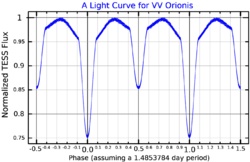Astronomy:VV Orionis
| Observation data Equinox J2000.0]] (ICRS) | |
|---|---|
| Constellation | Orion |
| Right ascension | 05h 33m 31.44649s[1] |
| Declination | −01° 09′ 21.8595″[1] |
| Apparent magnitude (V) | 5.31 (- 5.55) - 5.66[2] |
| Characteristics | |
| Evolutionary stage | B1V + B7V[3] |
| U−B color index | −0.09[4] |
| B−V color index | −0.18[4] |
| Variable type | Eclipsing,[5] β Cephei[3] |
| Astrometry | |
| Radial velocity (Rv) | 22.2[6] km/s |
| Proper motion (μ) | RA: −1.088[1] mas/yr Dec.: −1.183[1] mas/yr |
| Parallax (π) | 2.2654 ± 0.1138[1] mas |
| Distance | 1,210 ± 39 ly (371 ± 12[3] pc) |
| Absolute bolometric magnitude (Mbol) | −5.36 + −1.65[3] |
| Orbit[3] | |
| Period (P) | 1.4853784 days |
| Semi-major axis (a) | 13.51 R☉ |
| Eccentricity (e) | 0 |
| Inclination (i) | 78.28° |
| Details[3] | |
| VV Ori A | |
| Mass | 9.52 M☉ |
| Radius | 4.958 R☉ |
| Luminosity | 10,400 L☉ |
| Surface gravity (log g) | 4.026 cgs |
| Temperature | 26,200 K |
| VV Ori B | |
| Mass | 3.80 M☉ |
| Radius | 2.360 R☉ |
| Luminosity | 339 L☉ |
| Surface gravity (log g) | 4.272 cgs |
| Temperature | 16,100 K |
| Other designations | |
| Database references | |
| SIMBAD | data |
VV Orionis is an eclipsing binary located in the belt region of the constellation Orion. It is a faint naked eye star.
The brightness of VV Orionis dips regularly every 18 hours. The peak visual magnitude is 5.3, which varies slowly in between the dips. The minimum brightness of the dips alternates between magnitude 5.55 and 5.66. The deep minima have a somewhat rounded bottom, while the less deep minima have flat bottoms with a constant magnitude for several hours.[5] However, there are also additional cycles in the lightcurve that suggest that at least one of the stars is pulsating.[3]
The VV Orionis system contains two stars which are very close but are not touching. Their orbit is aligned almost perpendicularly to us and there are both primary and secondary eclipses. During secondary eclipse, the primary transits against the secondary, which produces the flat bottom to the secondary minimum. The orbital alignment allows very precise calculation of the orbit and the properties of the stars, but results from different studies have been unusually inconsistent. The lack of a single consistent solution to the orbit has led to suggestions that there is a third star in the system,[8] but this is unproven. A circular orbit with the stars only 13.5 R☉ apart can account for the observed brightness and radial velocity changes,[5] while a third body may explain the decreasing orbital inclination.[3]
The two stars are both on the main sequence. The primary, a β Cephei pulsator, has a spectral type of B1 and temperature of about 26,000 K, while the secondary (possibly a slowly pulsating B-type star) has a spectral type of B7 and a temperature of about 16,000 K. The secondary has a mass of 3.8 M☉, radius of 2.4 R☉, and bolometric luminosity of 340 L☉. The primary is over twice the mass, twice the radius, and thirty times the luminosity of its companion.[3]
References
- ↑ 1.0 1.1 1.2 1.3 1.4 Brown, A. G. A. (2021). "Gaia Early Data Release 3: Summary of the contents and survey properties". Astronomy & Astrophysics 649: A1. doi:10.1051/0004-6361/202039657. Bibcode: 2021A&A...649A...1G. Gaia EDR3 record for this source at VizieR.
- ↑ Samus, N. N. et al. (2009). "VizieR Online Data Catalog: General Catalogue of Variable Stars (Samus+ 2007-2013)". VizieR On-line Data Catalog: B/GCVS. Originally Published in: 2009yCat....102025S 1. Bibcode: 2009yCat....102025S.
- ↑ 3.0 3.1 3.2 3.3 3.4 3.5 3.6 3.7 3.8 Southworth, John; Bowman, D. M.; Pavlovski, K. (2021). "A β Cephei pulsator and a changing orbital inclination in the high-mass eclipsing binary system VV Orionis". Monthly Notices of the Royal Astronomical Society: Letters 501 (1): L65–L70. doi:10.1093/mnrasl/slaa197. Bibcode: 2021MNRAS.501L..65S.
- ↑ 4.0 4.1 Ducati, J. R. (2002). "VizieR Online Data Catalog: Catalogue of Stellar Photometry in Johnson's 11-color system". CDS/ADC Collection of Electronic Catalogues 2237. Bibcode: 2002yCat.2237....0D.
- ↑ 5.0 5.1 5.2 Terrell, Dirk; Munari, Ulisse; Siviero, Alessandro (2007). "Observational studies of early-type binary stars: VV Orionis". Monthly Notices of the Royal Astronomical Society 374 (2): 530–534. doi:10.1111/j.1365-2966.2006.11162.x. Bibcode: 2007MNRAS.374..530T.
- ↑ Wilson, Ralph Elmer (1953). "General catalogue of stellar radial velocities". Washington. Bibcode: 1953GCRV..C......0W.
- ↑ "MAST: Barbara A. Mikulski Archive for Space Telescopes". Space Telescope Science Institute. https://mast.stsci.edu/portal/Mashup/Clients/Mast/Portal.html.
- ↑ Chambliss, Carlson R. (1984). "VV Orionis: A well-behaved early-type eclipsing binary system". Astrophysics and Space Science 99 (1–2): 163–170. doi:10.1007/BF00650241. Bibcode: 1984Ap&SS..99..163C.
External links
- VV Orionis Jim Kaler
 |



